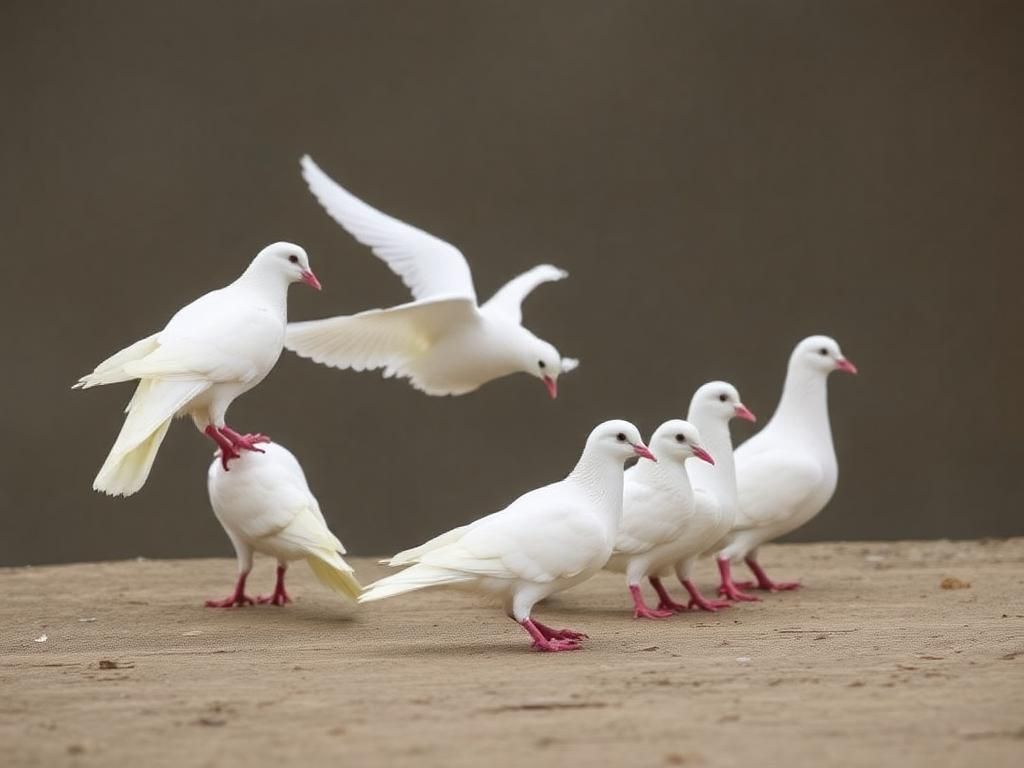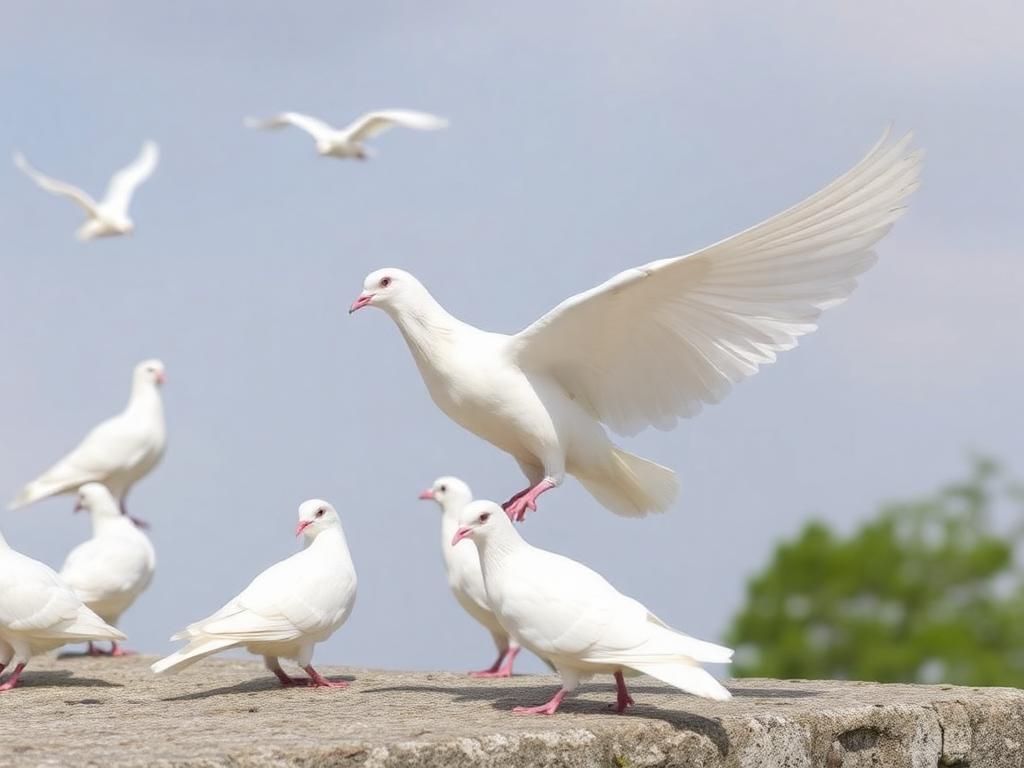White pigeons, often recognized for their stunning, pure plumage, play a significant role in various cultures around the world. These birds, a type of domestic pigeon, are not only visually striking but also rich in symbolism and historical relevance. Throughout history, they have been associated with themes of peace, love, and hope, making them revered in art, literature, and spiritual contexts.
This article aims to provide a comprehensive overview of white pigeons, exploring their biological characteristics, social behaviors, cultural significance, care, and the challenges they face, all while integrating practical knowledge for enthusiasts and conservationists alike.
The Biology of White Pigeons
Taxonomy and Classification
Overview of the Pigeon Family (Columbidae)
The family Columbidae includes a diverse range of birds commonly known as pigeons and doves. Within this family, white pigeons stand out due to their distinct coloration. While often mistaken for doves, white pigeons belong to the same family.
Distinction Between White Pigeons and Common Pigeon Species
Most commonly, white pigeons are referred to as the White Homing Pigeon. Unlike typical city pigeons, which are generally a blend of grays and browns, white pigeons have been selectively bred for their immaculate feathers, resulting in their iconic appearance.
Physical Characteristics
Description of Plumage and Size
White pigeons exhibit bright, snowy plumage, an average body length ranging from 12 to 14 inches, and a wingspan of approximately 24 to 28 inches. Their size can vary; however, they are generally robust birds.
Unique Features Such as Eye Color and Beak Shape
Aside from their white feathers, white pigeons typically have red or orange eyes, which complement their distinctive appearance. Their beaks are short and stout, adapted for their grain-based diet.
Habitat and Distribution
Natural Habitats of White Pigeons
White pigeons naturally thrive in various environments, including rural farmlands and urban areas. They often prefer habitats where they can find food easily, such as parks and gardens.
Geographic Distribution Globally
Originally found in Europe, white pigeons have spread globally due to domestication and selective breeding. They can now be seen in many countries around the world.
Adaptations to Urban vs. Rural Environments
White pigeons have shown remarkable adaptability to urban settings, learning to navigate around human populations. However, they often prefer the quiet pastoral settings of the countryside for breeding.
Behavior and Social Structure
Social Behavior
Group Dynamics in Flocks
In nature, white pigeons exhibit strong flocking behavior. They enjoy the company of their peers and establish tight social bonds within their groups, which aids in protection from predators.
Communication Methods (Cooing, Body Language)
Communication among white pigeons is multifaceted, including soft cooing sounds and visual signals through body posture and head movements.
Mating and Reproduction
Courtship Rituals
During the breeding season, male white pigeons perform elaborate courtship displays, including puffing up their chests and making cooing sounds to attract females.
Nesting Habits and Care of Young
White pigeons typically build simple nests in sheltered spots and diligently care for their young. Both male and female pigeons participate in the feeding and nurturing process.
Lifespan and Health
Average Lifespan in the Wild and Captivity
The average lifespan of a white pigeon ranges from 5 to 15 years, depending on environmental factors and living conditions. In captivity, with meticulous care, they can live even longer.

Common Health Issues and Veterinary Care
Like all animals, white pigeons can encounter health issues, including respiratory problems and parasites. Regular veterinary check-ups are essential for their well-being.
Cultural Significance
Symbolism of White Pigeons
Associated Meanings in Various Cultures (Peace, Love, Hope)
Across numerous cultures, white pigeons symbolize peace, love, and hope. In Christianity, they are often associated with the Holy Spirit, while in ancient Greek culture, they represented love and fertility.
Historical Significance in Religion and Spirituality
Throughout history, white pigeons have held a significant place in religious rituals. They are often released during important ceremonies such as weddings or memorials, symbolizing the release of souls and the dawn of new beginnings.
White Pigeons in Art and Literature
Representation in Paintings, Sculptures, and Literature
Artists have been captivated by the beauty and symbolism of white pigeons. From Picasso’s works to countless poetic references, these birds have adorned the canvas and written word, enhancing narratives of love and tranquility.
Famous Quotes and Imagery Involving White Pigeons
Notable authors and thinkers have often invoked the imagery of white pigeons in their quotes, encapsulating the essence of hope and peace, notably in the works of writers like John Milton and William Blake.
White Pigeons in Ceremonial Uses
Use in Weddings, Memorials, and Other Ceremonies
White pigeons are popularly released in various ceremonies to symbolize love and the spirit of the departed. This practice is steeped in tradition and continues to be a cherished custom.
Ethical Considerations Regarding Their Release
While releasing white pigeons can be beautiful, it raises ethical concerns about their welfare post-release. To address this, it’s essential to ensure they are properly trained to return home and are released responsibly.
Breeding and Keeping White Pigeons
Choosing the Right Breed
Overview of Common Breeds of White Pigeons (e.g., White Homing Pigeons)
Some prominent breeds include the White Homing Pigeon, recognized for its exceptional navigation skills, and the white King pigeon, known for its size and appearance.
Considerations for Selecting a Breed
When choosing a breed, consider factors such as living space, purpose (showing, racing, or as pets), and the specific characteristics that appeal to you.
Housing and Care
Ideal Living Conditions (Aviary Setup)
Creating a suitable aviary for white pigeons is crucial. The enclosure should be spacious, well-ventilated, and protected from harsh weather, with adequate nesting materials.
Diet and Feeding Habits
A diet rich in seeds, grains, fruits, and vegetables contributes to the health of white pigeons. Supplementing their diet with minerals and grit is also essential for digestive health.
Training White Pigeons
Basics of Training for Homing and Performance
Training white pigeons for homing involves gradual distance increases and the establishment of a strong bond between the bird and its trainer. Consistent practice and positive reinforcement are key.
Tips for Successful Training Methods
Utilize small treats as rewards, keep training sessions short, and gradually increase challenges to ensure the pigeons remain engaged and motivated.

Challenges and Conservation
Environmental Threats
Habitat Loss and Urbanization
The natural habitats of white pigeons are threatened due to urbanization and agricultural developments. This results in a decrease in safe nesting spots and foraging areas.
Predation and Disease Risks
Urban environments can also heighten the risk of predation by cats and other animals. Additionally, diseases can proliferate in densely populated pigeon areas, affecting their health.
Conservation Efforts
Organizations Dedicated to Pigeon Conservation
Numerous organizations focus on protecting various bird species, including white pigeons. Groups like the BirdLife International undertake significant efforts in habitat preservation and species recovery.
Importance of Responsible Breeding and Care Practices
Encouraging responsible breeding practices helps maintain genetic diversity and ensures that health standards are upheld in white pigeon populations.
Conclusion
Emphasizing the balance between the ecological role and cultural significance of white pigeons, the ongoing conservation efforts are vital. As these graceful birds continue to flit through urban and rural landscapes, understanding their biology, behavior, and cultural meanings enhances our appreciation and encourages responsible stewardship.
Additional Resources
Recommended Reading
– “Birds of the World: A Complete Guide to Birds” by John James Audubon
– “Pigeons and Doves: A Guide to the World’s Pigeons” by David Attenborough
Organizations to Follow
– The Pigeon Club
– Audubon Society
Online Communities and Forums
– Pigeon Lovers Forums
– Birdwatching Online Communities
FAQ Section
1. What are white pigeons commonly used for?
White pigeons are often used in ceremonial releases for weddings, memorials, and other significant events, symbolizing peace and love.
2. How can I care for my white pigeons effectively?
Providing a spacious aviary, a balanced diet, regular health check-ups, and social interaction ensures their well-being.
3. Do white pigeons return home after being released?
Yes, trained white homing pigeons possess strong navigational abilities and can return to their home lofts if released properly.
4. What is the average lifespan of a white pigeon?
In captivity, white pigeons can live up to 15 years, while in the wild, their average lifespan is around 5 to 10 years.
5. Are white pigeons endangered?
While not currently classified as endangered, habitat loss and urban threats require ongoing conservation efforts to ensure their populations remain stable.
6. Can white pigeons be house pets?
Yes, white pigeons can be kept as pets, but they require a suitable living environment and social interaction for a fulfilling life.
7. Why are white pigeons important in culture?
White pigeons carry significant symbolism in many cultures, often representing peace, love, and hope in various ceremonies and artistic expressions.
8. What should I feed my white pigeons?
A diet primarily consisting of grains, seeds, fresh fruits, and vegetables, supplemented with minerals, will keep your white pigeons healthy.
9. How do I train my white pigeons for homing?
Start with short distances, gradually increasing the distance over time. Use treats as rewards to encourage their return.
10. Where can I learn more about the care and breeding of white pigeons?
Consider joining forums, reading books about pigeon care, and following organizations dedicated to bird conservation and welfare for reliable resources.
